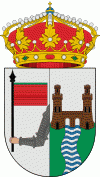Zamora (Zamora)
 |
 |
Zamora is part of the natural comarca of Tierra del Pan and it is the head of the judicial district of Zamora.
The city was founded early in the Bronze Age and was later occupied during the Iron Age by the Celtic people of the Vacceos who called it Ocalam.
After the Roman victory over the Lusitanian hero Viriathus the settlement was named by the Romans Occelum Durii or Ocellodurum (literally, "Eye of the Duero"). During Roman rule it was in the hands of the Vaccaei, and was incorporated into the Roman province of Hispania Tarraconensis. It was on the road from Emerita (modern Mérida) to Asturica Augusta (modern Astorga). (Ant. Itin. pp. 434, 439).
Two coins from the reign of the Visigothic king Sisebuto, show that it was known at the time as "Semure".
Following the campaigns of Musa ibn Nusayr in the 710s in the context of the Umayyad conquest of the Iberian Peninsula, the town was conquered and a Berber garrison was left in the there, but following the Arab-Berber strifes, the territory was reportedly seized by Alfonso I of Asturias. Not much attention was paid however to the place in the chronicles from this period, as Asturian human resources at the time were mostly targeted at the Cantabrian coast and little is known about the inhabitants of the Duero Valley.
According to the chronicle of Al-Andalus by Isa ibn Ahmad al-Razi, Alfonso III of Asturias determined the Christian repopulation of the place in 280 AH (893–894 AD) (although the dates of 881, 899 and 910 AD have been also reported). A diocese and a bishop were established in the town in the early 10th century. Mozarab builders came from Toledo. The city became one of the most thriving Christian cities in Iberia in the early 10th century, possibly even passing León.
Zamora became the target of Ibn al-Qitt, who unsuccessfully tried to invade the city in 901 with help from Nafzāwa Berbers. It was also attacked several times during the Caliphal era, and Almanzor eventually seized the city in 966. The place returned to Christian control during the reign of Alfonso V of León.
Since the early 11th century, with the repopulation works by Raymond of Burgundy, the place saw planned repopulating efforts. A new perimeter of city walls was also erected in the 11th century. The population intramuros included the nobles and regal officers, the clergy, Frank settlers from Gascogne, Poitou and Provence who had installed in the city during the time of Raymond of Burgundy, settlers of Asturian, Leonese and Galician origin, as well as some Mozarabs. Zamora was granted a fuero in 1208.
The most notable historic episode in Zamora was the assassination outside the city walls of the king Sancho II of Castile in 1072. Some decades before, king Ferdinand I of León had divided his kingdoms between his three sons. To his daughter, Doña Urraca, he had bequeathed the "well fortified city of Zamora" (or "la bien cercada" in Spanish). All three sons warred among themselves, till the ultimate winner, Sancho, was left victorious. Zamora, under his sister who was allied with Leonese nobles, resisted. Sancho II of Castile, assisted by El Cid, laid siege to Zamora. King Sancho II was murdered by a duplicitous noble of Zamora, Bellido Dolfos, who tricked the king into a private meeting. After the death of Sancho, Castile reverted to his deposed brother Alfonso VI of León. The event was commemorated by the Portillo de la Traición (Treason Gate).
Map - Zamora (Zamora)
Map
Country - Spain
 |
 |
| Flag of Spain | |
Anatomically modern humans first arrived in the Iberian Peninsula around 42,000 years ago. The ancient Iberian and Celtic tribes, along with other pre-Roman peoples, dwelled the territory maintaining contacts with foreign Mediterranean cultures. The Roman conquest and colonization of the peninsula (Hispania) ensued, bringing the Romanization of the population. Receding of Western Roman imperial authority ushered in the migration of different non-Roman peoples from Central and Northern Europe with the Visigoths as the dominant power in the peninsula by the fifth century. In the early eighth century, most of the peninsula was conquered by the Umayyad Caliphate, and during early Islamic rule, Al-Andalus became a dominant peninsular power centered in Córdoba. Several Christian kingdoms emerged in Northern Iberia, chief among them León, Castile, Aragon, Portugal, and Navarre made an intermittent southward military expansion, known as Reconquista, repelling the Islamic rule in Iberia, which culminated with the Christian seizure of the Emirate of Granada in 1492. Jews and Muslims were forced to choose between conversion to Catholicism or expulsion, and eventually the converts were expelled through different royal decrees.
Currency / Language
| ISO | Currency | Symbol | Significant figures |
|---|---|---|---|
| EUR | Euro | € | 2 |
| ISO | Language |
|---|---|
| EU | Basque language |
| CA | Catalan language |
| GL | Galician language |
| OC | Occitan language |
| ES | Spanish language |















